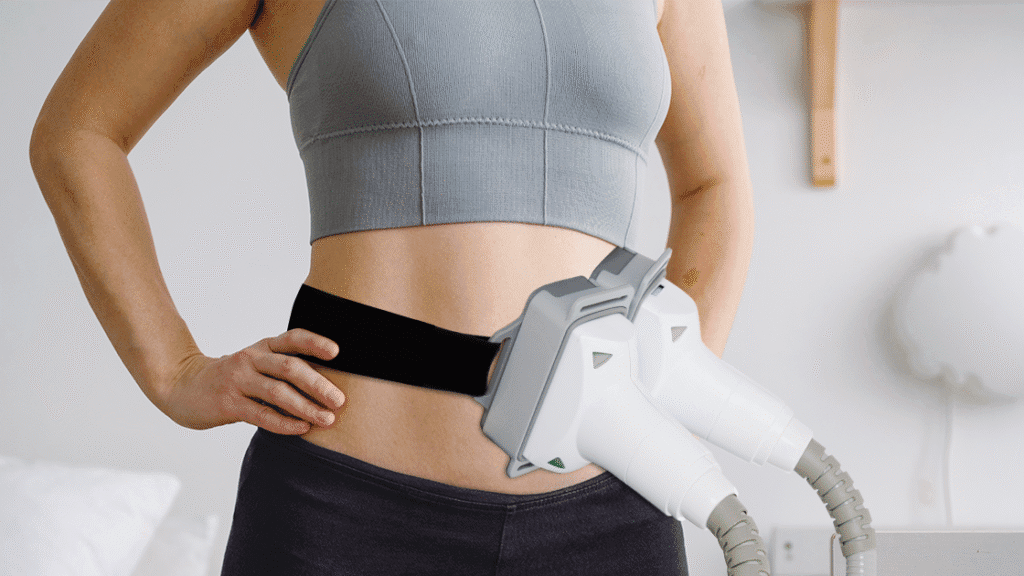1. Introduction: Understanding Laser Lipolysis
The quest for effective body contouring solutions has led to significant advances in non-invasive aesthetic treatments. Among these innovations, laser lipolysis has emerged as a popular alternative to traditional surgical procedures, offering patients a way to target stubborn fat deposits without the risks and downtime associated with invasive surgery.
1.1 What Is Laser Lipolysis?
Laser lipolysis, also known as laser-assisted lipolysis or non-invasive laser fat reduction, is a minimally invasive cosmetic procedure that uses targeted laser energy to break down adipose tissue. This advanced technique employs specific wavelengths of laser light to selectively target and disrupt fat cells (adipocytes) while preserving surrounding tissues. The procedure represents a significant advancement in body contouring technology, offering patients precise fat reduction with minimal recovery time.
1.2 How Does Laser Lipolysis Work for Fat Removal?
The mechanism of laser lipolysis involves the application of diode laser technology that penetrates the skin to reach subcutaneous fat layers. The laser energy creates controlled thermal damage to adipocytes, causing them to release their stored lipids through a process called lipolysis. This cellular disruption triggers the body’s natural lymphatic drainage system to eliminate the released fatty acids and glycerol. The precision of modern diode laser systems allows for selective targeting of fat cells while maintaining the integrity of surrounding dermal and epidermal structures.
1.3 The Appeal of Non-Surgical Fat Reduction
Traditional liposuction procedures, while effective, carry inherent surgical risks including infection, scarring, and extended recovery periods. Laser lipolysis addresses these concerns by offering a non-surgical alternative that requires no general anesthesia or surgical incisions. Patients appreciate the ability to return to normal activities shortly after treatment, making it an attractive option for those with busy lifestyles. The procedure’s precision also allows for treatment of smaller, more delicate areas that may be challenging to address through conventional surgical methods.
1.4 Key Benefits of Laser Lipolysis
The advantages of laser lipolysis extend beyond simple fat reduction. The thermal energy delivered by diode lasers stimulates collagen production, leading to improved skin tightening and texture enhancement. Additionally, the procedure typically requires multiple sessions, allowing for gradual, natural-looking results that appear more subtle than dramatic surgical transformations. The outpatient nature of the treatment, combined with minimal side effects such as temporary erythema or mild edema, makes it accessible to a broader range of patients seeking body contouring solutions.
2. Does Fat Come Back After Laser Lipolysis?
Understanding the long-term effectiveness of laser lipolysis requires examining the fundamental biology of adipose tissue and how laser energy affects cellular structure. This scientific foundation is crucial for setting realistic expectations about treatment outcomes and permanence.
2.1 The Science Behind Fat Cells and Laser Lipolysis
Adult humans possess a relatively fixed number of adipocytes, typically established during childhood and adolescence. When diode laser energy is applied during lipolysis, it causes irreversible damage to the cellular membrane of these fat cells through photothermolysis. The disrupted adipocytes release their contents and are gradually eliminated through the lymphatic system and liver metabolism. This process, known as apoptosis or programmed cell death, permanently removes the treated fat cells from the targeted area, creating the foundation for lasting results.
2.2 Can Fat Rebuild After Laser Lipolysis?
The regeneration of new adipocytes in treated areas is generally limited in healthy adults. However, existing fat cells in both treated and untreated areas retain the capacity for hypertrophy – the ability to increase in size by storing additional lipids. This means that while destroyed fat cells cannot regenerate, remaining cells can expand if caloric intake exceeds energy expenditure. Understanding this distinction is crucial for patients considering laser lipolysis, as it highlights the importance of maintaining stable body weight post-treatment.
2.3 How Laser Lipolysis Affects Fat Cells Permanently
The thermal effects of diode laser energy create permanent structural changes within targeted adipocytes. The laser wavelength penetrates to the appropriate depth, causing coagulation of cellular proteins and disruption of lipid storage mechanisms. Once this cellular damage occurs, the affected adipocytes cannot recover their normal function. The body’s immune system recognizes these damaged cells as foreign material, initiating an inflammatory response that leads to their removal through macrophage activity and lymphatic drainage.
2.4 Factors That Influence Fat Reformation Post-Treatment
Several physiological and lifestyle factors can influence the appearance of fat reformation after laser lipolysis. Hormonal fluctuations, particularly changes in insulin sensitivity and cortisol levels, can affect how remaining adipocytes respond to dietary intake. Additionally, the distribution of alpha and beta adrenergic receptors in different body regions influences how effectively these areas respond to both fat storage and mobilization signals. Genetic predisposition also plays a role in determining individual patterns of fat distribution and metabolic response.
3. Why Does Fat Come Back? Key Factors to Consider
While laser lipolysis permanently destroys treated fat cells, several factors can create the appearance of fat “returning” to treated areas. Understanding these mechanisms helps patients make informed decisions about post-treatment lifestyle modifications.

3.1 Lifestyle Choices: Diet and Exercise
Dietary habits significantly impact the long-term success of laser lipolysis treatments. Excessive caloric intake, particularly from refined carbohydrates and saturated fats, can lead to hypertrophy of remaining adipocytes in treated areas. Additionally, sedentary behavior reduces metabolic rate and decreases the body’s ability to mobilize stored fats effectively. Maintaining a balanced macronutrient ratio with adequate protein intake supports lean muscle mass, which enhances overall metabolic efficiency and helps prevent compensatory fat storage in untreated areas.
3.2 Genetics: How Your Body Responds to Fat Storage
Individual genetic variations affect lipid metabolism, hormone sensitivity, and regional fat distribution patterns. Polymorphisms in genes such as FTO (fat mass and obesity-associated gene) and MC4R (melanocortin 4 receptor) influence appetite regulation and energy expenditure. These genetic factors can predispose certain individuals to preferential fat storage in specific body regions, potentially affecting the long-term appearance of laser lipolysis results. Understanding personal genetic predispositions helps set realistic expectations for treatment outcomes and maintenance requirements.
3.3 Hormonal Influence on Fat Rebuild
Hormonal fluctuations significantly impact adipose tissue metabolism and distribution. Insulin resistance can promote lipogenesis (fat formation) and inhibit lipolysis (fat breakdown), particularly in visceral and subcutaneous abdominal regions. Cortisol elevation from chronic stress promotes central adiposity and can counteract the benefits of laser lipolysis. In women, estrogen fluctuations during menstrual cycles, pregnancy, or menopause can alter fat distribution patterns, potentially affecting the appearance of treated areas over time.
3.4 Weight Fluctuations and Their Impact on Results
Significant weight gain following laser lipolysis can compromise treatment results by causing hypertrophy of remaining adipocytes and compensatory fat storage in untreated areas. Even moderate weight fluctuations of 10-15 pounds can noticeably affect body contours in patients who have undergone fat reduction procedures. Maintaining stable body weight within 5-10% of post-treatment weight helps preserve the contouring effects achieved through laser lipolysis and prevents the appearance of fat reformation in treated regions.
4. Maintaining Long-Term Results After Laser Lipolysis
Successful long-term outcomes from laser lipolysis depend largely on post-treatment lifestyle modifications and maintenance strategies. These approaches focus on supporting the body’s natural fat metabolism while preventing compensatory weight gain.
4.1 Healthy Eating Habits to Support Fat Loss
Implementing a sustainable nutrition plan emphasizes whole foods, adequate protein intake, and controlled portion sizes. Anti-inflammatory foods such as omega-3 fatty acids, antioxidant-rich vegetables, and lean proteins support cellular recovery and optimize metabolic function. Limiting processed foods, refined sugars, and trans fats helps prevent rapid fluctuations in blood glucose and insulin levels that can promote fat storage. Meal timing strategies, including intermittent fasting protocols, may enhance the body’s ability to mobilize stored fats and maintain metabolic flexibility.
4.2 Incorporating Regular Exercise: Key Activities for Long-Term Results
A comprehensive exercise program combining cardiovascular training and resistance exercises optimally supports laser lipolysis results. High-intensity interval training (HIIT) enhances post-exercise oxygen consumption (EPOC), promoting continued fat oxidation after workouts. Resistance training preserves lean muscle mass, which maintains elevated metabolic rate and improves insulin sensitivity. Low-impact activities such as walking, swimming, or cycling provide sustainable options for patients who may experience temporary mobility limitations immediately following treatment sessions.
4.3 Staying Hydrated for Optimal Skin Tightening
Adequate hydration supports the lymphatic system’s ability to eliminate metabolic waste products and cellular debris following laser lipolysis. Proper hydration also maintains skin elasticity and supports collagen synthesis, enhancing the skin tightening effects of laser treatment. Consuming 8-10 glasses of water daily, along with electrolyte balance through natural sources, optimizes cellular function and supports the body’s natural detoxification processes. Limiting dehydrating substances such as excessive caffeine and alcohol helps maintain optimal fluid balance.
4.4 The Role of Sleep in Fat Reduction and Skin Health
Quality sleep directly impacts hormonal regulation, particularly growth hormone and cortisol production, which influence fat metabolism and tissue repair. During deep sleep phases, the body releases growth hormone, which promotes lipolysis and supports cellular regeneration. Sleep deprivation disrupts leptin and ghrelin balance, leading to increased appetite and cravings for high-calorie foods. Maintaining 7-9 hours of quality sleep nightly supports optimal recovery following laser lipolysis and helps maintain long-term treatment results.
4.5 Managing Stress to Prevent Fat Accumulation
Chronic stress elevates cortisol levels, promoting visceral fat accumulation and interfering with the body’s ability to mobilize stored fats effectively. Stress management techniques such as meditation, yoga, or deep breathing exercises help regulate the hypothalamic-pituitary-adrenal axis and support healthy cortisol patterns. Regular stress reduction practices also improve sleep quality and reduce emotional eating behaviors that can compromise laser lipolysis results. Incorporating stress management into daily routines enhances overall treatment outcomes and supports long-term success.

5. Post-Treatment Care for Best Results
Proper post-treatment care is essential for optimizing laser lipolysis outcomes and minimizing potential complications. Following established protocols helps ensure safe healing and maximizes the effectiveness of the treatment.
5.1 Immediate Aftercare: What to Expect After Laser Lipolysis
Following laser lipolysis, patients typically experience mild erythema, edema, and tenderness in treated areas for 24-48 hours. These normal inflammatory responses indicate successful cellular disruption and the initiation of healing processes. Applying cold compresses intermittently during the first 24 hours helps reduce inflammation and provides comfort. Patients should avoid hot baths, saunas, or intense physical activity for 48-72 hours to prevent excessive swelling and support optimal healing conditions.
5.2 Skin Care Tips to Enhance Laser Lipolysis Outcomes
Maintaining proper skin care during the healing process supports optimal results and enhances the skin tightening effects of laser treatment. Gentle cleansing with pH-balanced products prevents irritation while maintaining skin barrier function. Applying medical-grade moisturizers containing ingredients such as hyaluronic acid, ceramides, or peptides supports hydration and collagen synthesis. Avoiding harsh exfoliants, retinoids, or chemical peels for 1-2 weeks following treatment prevents excessive irritation and allows proper healing to occur.
5.3 Avoiding Common Mistakes That Can Interfere with Results
Common post-treatment mistakes include premature return to vigorous exercise, excessive sun exposure, and inadequate hydration. Intense physical activity within 48 hours can increase inflammation and potentially interfere with the natural elimination of damaged fat cells. Unprotected sun exposure to treated areas can cause hyperpigmentation and delay healing processes. Insufficient water intake impairs lymphatic drainage and slows the removal of cellular debris, potentially diminishing treatment effectiveness and prolonging recovery time.
5.4 Follow-Up Sessions: When and Why They’re Important
Most laser lipolysis protocols require multiple treatment sessions spaced 2-4 weeks apart to achieve optimal results. This staged approach allows for gradual fat reduction and proper healing between sessions. Follow-up appointments enable practitioners to assess treatment response, adjust parameters if necessary, and monitor for any adverse reactions. Scheduling maintenance sessions every 6-12 months may help preserve results and address new areas of concern as they develop over time.
6. Additional Options to Enhance and Maintain Results
Combining laser lipolysis with complementary treatments and lifestyle modifications can enhance overall outcomes and extend the longevity of results. These adjunctive approaches target different aspects of body contouring and skin health.
6.1 Combining Laser Lipolysis with Other Non-Invasive Treatments
Radiofrequency treatments can complement laser lipolysis by providing additional skin tightening through deep dermal heating and collagen stimulation. Cryolipolysis (controlled cooling) targets different fat cell populations and can address areas not optimal for laser treatment. Ultrasound-based treatments such as focused ultrasound therapy provide mechanical disruption of fat cells through cavitation effects. Combining these modalities allows for comprehensive body contouring that addresses both fat reduction and skin laxity concerns simultaneously.
6.2 Surgical Procedures: When to Consider Alternatives
Patients with significant skin laxity, large volumes of excess fat, or specific anatomical concerns may benefit more from surgical alternatives such as traditional liposuction or abdominoplasty. Those with BMI greater than 30 or unrealistic expectations about non-invasive results may be better candidates for surgical intervention. Medical contraindications such as bleeding disorders, active infections, or certain medications may also necessitate alternative treatment approaches. Consultation with qualified plastic surgeons helps determine the most appropriate treatment modality for individual circumstances.
6.3 The Importance of Regular Check-Ups with a Qualified Professional
Ongoing professional monitoring ensures optimal long-term results and early detection of any complications or concerns. Regular assessments allow for treatment plan modifications based on individual response patterns and changing aesthetic goals. Professional guidance helps patients maintain realistic expectations and provides support for lifestyle modifications that support treatment outcomes. Establishing a long-term relationship with qualified practitioners ensures access to the latest technological advances and treatment protocols as they become available.
7. Realistic Expectations: What Laser Lipolysis Can and Can’t Do
Setting appropriate expectations is crucial for patient satisfaction and treatment success. Understanding the capabilities and limitations of laser lipolysis helps patients make informed decisions about their body contouring goals.
7.1 The Limitations of Laser Lipolysis in Fat Removal
Laser lipolysis is most effective for treating localized fat deposits and mild to moderate skin laxity rather than significant weight loss or major body contouring. The procedure typically reduces fat layer thickness by 20-25% per treatment session, making it unsuitable for patients seeking dramatic transformations. Areas with fibrous or dense fat deposits may respond less favorably to laser treatment compared to softer adipose tissue. Patients with unrealistic expectations about achieving surgical-level results through non-invasive means may experience disappointment with treatment outcomes.
7.2 Ideal Candidates for Laser Lipolysis
Optimal candidates are within 20-30 pounds of their ideal body weight with good skin elasticity and localized areas of stubborn fat resistant to diet and exercise. Patients should have realistic expectations about gradual improvement over several months rather than immediate dramatic results. Good overall health, absence of active skin conditions in treatment areas, and commitment to post-treatment lifestyle modifications contribute to successful outcomes. Non-smokers with stable body weight and no history of keloid scarring typically achieve the best results from laser lipolysis treatments.
7.3 Understanding the Long-Term Commitment Required
Maintaining laser lipolysis results requires ongoing commitment to healthy lifestyle choices including proper nutrition, regular exercise, and stress management. Patients must understand that the procedure provides a foundation for improved body contours but does not prevent future weight gain or eliminate the need for healthy habits. Long-term success depends on treating laser lipolysis as part of a comprehensive wellness approach rather than a standalone solution. Regular maintenance treatments may be necessary to address new areas of concern or maintain optimal results over time.

8. Expert Advice: What Dermatologists and Surgeons Recommend
Professional insights from qualified practitioners provide valuable guidance for optimizing laser lipolysis outcomes and maintaining long-term results. These recommendations are based on clinical experience and scientific evidence.
8.1 Professional Insights on Fat Reformation After Laser Lipolysis
Experienced practitioners emphasize that true fat reformation in treated areas is rare when proper technique and appropriate patient selection are employed. However, they note that weight gain can cause expansion of remaining fat cells, creating the appearance of fat return. Dermatologists stress the importance of patient education regarding the difference between new fat formation and existing cell enlargement. Surgeons recommend comprehensive pre-treatment counseling to ensure patients understand the permanent nature of fat cell destruction and the ongoing responsibility for weight maintenance.
8.2 Expert Tips for Maintaining Results
Leading practitioners recommend implementing lifestyle changes before beginning laser lipolysis treatments to establish sustainable habits that support long-term success. They advise patients to focus on gradual, sustainable modifications rather than extreme dietary restrictions that may lead to rebound weight gain. Experts emphasize the importance of building lean muscle mass through resistance training to maintain elevated metabolic rate and support continued fat oxidation. Regular monitoring of body composition rather than just weight helps patients track meaningful changes in fat and muscle distribution.
8.3 The Role of Professional Consultation in Achieving Desired Outcomes
Qualified practitioners stress the importance of thorough medical history evaluation, physical examination, and realistic goal-setting discussions before beginning treatment. Professional assessment helps identify potential contraindications, optimize treatment parameters, and develop individualized protocols for each patient. Ongoing professional guidance throughout the treatment process allows for real-time adjustments and addresses concerns as they arise. Practitioners emphasize that successful outcomes depend on the collaborative relationship between patient and provider, with shared responsibility for achieving and maintaining desired results.
9. Conclusion: Can Fat Return After Laser Lipolysis?
The question of fat reformation after laser lipolysis has a nuanced answer that depends on understanding the biological mechanisms involved and the factors that influence long-term outcomes. This comprehensive analysis provides clarity for patients considering this treatment option.
9.1 Key Takeaways on Fat Reformation Post-Laser Lipolysis
Laser lipolysis permanently destroys treated fat cells through controlled thermal damage, making true fat reformation in treated areas unlikely under normal circumstances. However, remaining adipocytes retain the capacity for expansion if energy balance becomes positive through excessive caloric intake or reduced energy expenditure. The appearance of fat “return” typically results from weight gain affecting both treated and untreated areas rather than regeneration of destroyed cells. Understanding this distinction helps patients maintain realistic expectations and implement appropriate maintenance strategies.
9.2 Final Thoughts on Long-Term Maintenance Strategies
Successful long-term outcomes from laser lipolysis depend heavily on patient commitment to healthy lifestyle modifications and ongoing professional guidance. The procedure provides an excellent foundation for body contouring when combined with appropriate nutrition, regular exercise, stress management, and adequate sleep. Patients who approach laser lipolysis as part of a comprehensive wellness strategy rather than a quick fix typically achieve the most satisfying and durable results. Regular professional monitoring and potential maintenance treatments help preserve outcomes and address new concerns as they develop over time. The investment in laser lipolysis extends beyond the initial treatment cost to include the ongoing commitment to healthy habits that support optimal results. When patients understand this comprehensive approach and maintain realistic expectations, laser lipolysis can provide significant improvements in body contours with minimal downtime and excellent safety profiles. The key to success lies in viewing the treatment as a catalyst for positive lifestyle changes rather than a substitute for healthy habits.
10. References
- SculpLase: Precision Fat Reduction for a Confident You
- PowerSculp 1064nm Laser Lipolysis System
- Slim Down with SculpLase: Laser Lipolysis at Its Finest
- Slimming Precision: Introducing SculpLase 1064nm Lipolysis
- Lipolysis Using a 980-nm Diode Laser: A Retrospective Analysis of 534 Procedures
Laser Lipolysis: An Update








